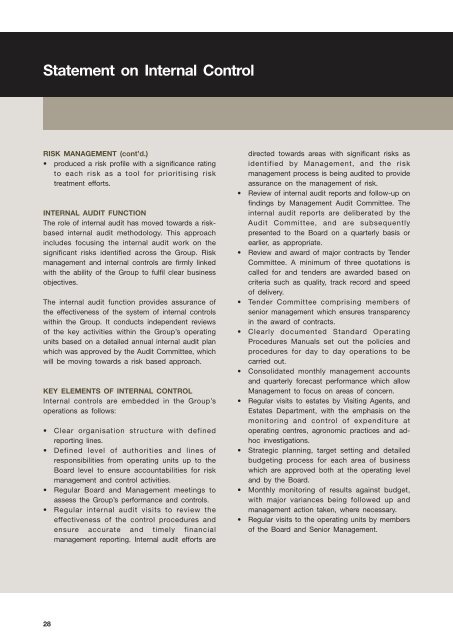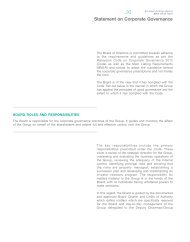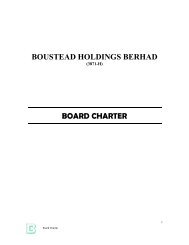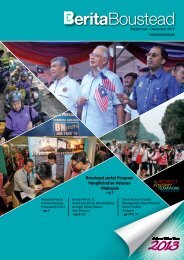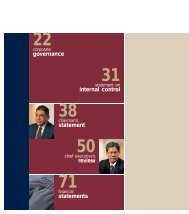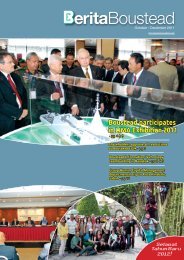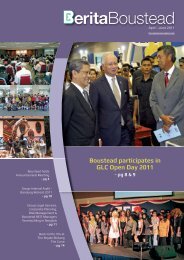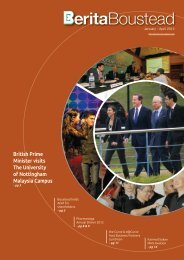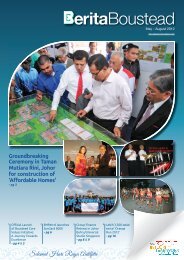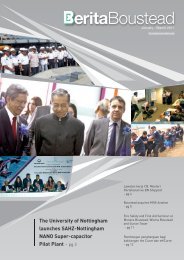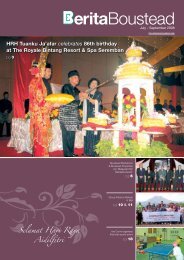Directors - Boustead Holdings Berhad
Directors - Boustead Holdings Berhad
Directors - Boustead Holdings Berhad
Create successful ePaper yourself
Turn your PDF publications into a flip-book with our unique Google optimized e-Paper software.
Statement on Internal Control<br />
RISK MANAGEMENT (cont’d.)<br />
• produced a risk profile with a significance rating<br />
to each risk as a tool for prioritising risk<br />
treatment efforts.<br />
INTERNAL AUDIT FUNCTION<br />
The role of internal audit has moved towards a riskbased<br />
internal audit methodology. This approach<br />
includes focusing the internal audit work on the<br />
significant risks identified across the Group. Risk<br />
management and internal controls are firmly linked<br />
with the ability of the Group to fulfil clear business<br />
objectives.<br />
The internal audit function provides assurance of<br />
the effectiveness of the system of internal controls<br />
within the Group. It conducts independent reviews<br />
of the key activities within the Group’s operating<br />
units based on a detailed annual internal audit plan<br />
which was approved by the Audit Committee, which<br />
will be moving towards a risk based approach.<br />
KEY ELEMENTS OF INTERNAL CONTROL<br />
Internal controls are embedded in the Group’s<br />
operations as follows:<br />
• Clear organisation structure with defined<br />
reporting lines.<br />
• Defined level of authorities and lines of<br />
responsibilities from operating units up to the<br />
Board level to ensure accountabilities for risk<br />
management and control activities.<br />
• Regular Board and Management meetings to<br />
assess the Group’s performance and controls.<br />
• Regular internal audit visits to review the<br />
effectiveness of the control procedures and<br />
ensure accurate and timely financial<br />
management reporting. Internal audit efforts are<br />
28<br />
directed towards areas with significant risks as<br />
identified by Management, and the risk<br />
management process is being audited to provide<br />
assurance on the management of risk.<br />
• Review of internal audit reports and follow-up on<br />
findings by Management Audit Committee. The<br />
internal audit reports are deliberated by the<br />
Audit Committee, and are subsequently<br />
presented to the Board on a quarterly basis or<br />
earlier, as appropriate.<br />
• Review and award of major contracts by Tender<br />
Committee. A minimum of three quotations is<br />
called for and tenders are awarded based on<br />
criteria such as quality, track record and speed<br />
of delivery.<br />
• Tender Committee comprising members of<br />
senior management which ensures transparency<br />
in the award of contracts.<br />
• Clearly documented Standard Operating<br />
Procedures Manuals set out the policies and<br />
procedures for day to day operations to be<br />
carried out.<br />
• Consolidated monthly management accounts<br />
and quarterly forecast performance which allow<br />
Management to focus on areas of concern.<br />
• Regular visits to estates by Visiting Agents, and<br />
Estates Department, with the emphasis on the<br />
monitoring and control of expenditure at<br />
operating centres, agronomic practices and adhoc<br />
investigations.<br />
• Strategic planning, target setting and detailed<br />
budgeting process for each area of business<br />
which are approved both at the operating level<br />
and by the Board.<br />
• Monthly monitoring of results against budget,<br />
with major variances being followed up and<br />
management action taken, where necessary.<br />
• Regular visits to the operating units by members<br />
of the Board and Senior Management.


